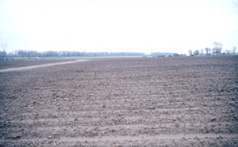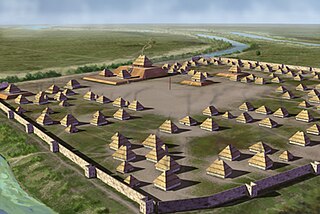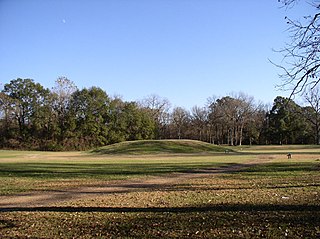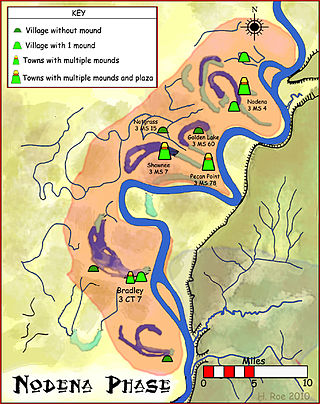
Etowah Indian Mounds (9BR1) are a 54-acre (220,000 m2) archaeological site in Bartow County, Georgia, south of Cartersville. Built and occupied in three phases, from 1000–1550 CE, the prehistoric site is located on the north shore of the Etowah River.

Angel Mounds State Historic Site, an expression of the Mississippian culture, is an archaeological site managed by the Indiana State Museum and Historic Sites that includes more than 600 acres of land about 8 miles (13 km) southeast of present-day Evansville, in Vanderburgh and Warrick counties in Indiana. The large residential and agricultural community was constructed and inhabited from AD 1100 to AD 1450, and served as the political, cultural, and economic center of the Angel chiefdom. It extended within 120 miles (190 km) of the Ohio River valley to the Green River in present-day Kentucky. The town had as many as 1,000 inhabitants inside the walls at its peak, and included a complex of thirteen earthen mounds, hundreds of home sites, a palisade (stockade), and other structures.

Wickliffe Mounds is a prehistoric, Mississippian culture archaeological site located in Ballard County, Kentucky, just outside the town of Wickliffe, about 3 miles (4.8 km) from the confluence of the Ohio and Mississippi rivers. Archaeological investigations have linked the site with others along the Ohio River in Illinois and Kentucky as part of the Angel phase of Mississippian culture. Wickliffe Mounds is controlled by the State Parks Service, which operates a museum at the site for interpretation of the ancient community. Listed on the National Register of Historic Places, it is also a Kentucky Archeological Landmark and State Historic Site.

Moundville Archaeological Site, also known as the Moundville Archaeological Park, is a Mississippian culture archaeological site on the Black Warrior River in Hale County, near the modern city of Tuscaloosa, Alabama. Extensive archaeological investigation has shown that the site was the political and ceremonial center of a regionally organized Mississippian culture chiefdom polity between the 11th and 16th centuries. The archaeological park portion of the site is administered by the University of Alabama Museums and encompasses 185 acres (75 ha), consisting of 29 platform mounds around a rectangular plaza.

Shiloh Indian Mounds Site (40HR7) is an archaeological site of the South Appalachian Mississippian culture. It is located beside the Tennessee River on the grounds of the Shiloh National Military Park, in Hardin County of southwestern Tennessee. A National Historic Landmark, it is one of the largest Woodland era sites in the southeastern United States.
Hitchiti was a tribal town in what is now the Southeast United States. It was first known as part of the Apalachicola Province, an association of tribal towns along the Chattahoochee River. Shortly after 1690, the towns of Apalachicola Province moved to the central part of present-day Georgia, with Hitchiti joining most of those towns along Ochese Creek. In 1715, most of the towns on Ochese Creek, including Hitchiti, moved back to the Chattahoochee River, where the town remained until its people were forced to move to the Indian Territory as part of the Trail of Tears. Hitchiti was one of several towns whose people spoke the Hitchiti language.
The Cayson Mound and Village Site (8CA3) is a prehistoric archaeological site located near Blountstown, Florida. It is located three miles southeast of Blountstown, on the Apalachicola River. The site was occupied by peoples of the Fort Walton Culture. On March 15, 1976, it was added to the U.S. National Register of Historic Places.
The Yon Mound and Village Site (8LI2) is a prehistoric archaeological site located two miles west of Bristol, Florida on the east bank of the Apalachicola River. The site was occupied by peoples of the Fort Walton Culture. On December 15, 1978, it was added to the U.S. National Register of Historic Places as reference number 78000952.
The Chisca were a tribe of Native Americans living in present-day eastern Tennessee and southwestern Virginia in the 16th century, and in present-day Alabama, Georgia, and Florida in the 17th, 18th, and early 19th centuries, by which time they were known as Yuchi. The Hernando de Soto expedition heard of, and may have had brief contact with, the Chisca in 1540. The Juan Pardo expeditions of 1566 and 1568 encountered the Chisca, and engaged in battles with them. By early in the 17th century, Chisca people were present in several parts of Spanish Florida, engaged at various times and places in alternately friendly or hostile relations with the Spanish and the peoples of the Spanish mission system. After the capture of a fortified Chisca town by the Spanish and Apalachee in 1677, some Chisca took refuge in northern Tennessee, where they were absorbed into the Shawnee, and in Muscogee towns in Alabama. Around the turn of the 18th century some Chisca, by then generally called Yuchi, joined the Apalachicola Province towns that resettled around Ochisi Creek in central Georgia, thus becoming part of the "Lower Towns of the Muscogee Confederacy". A few Chiscas remained in western Florida into the middle of the 18th century.
Apalachicola was the name of a Native American tribal town, and of a group of towns associated with it, which the Spanish called Apalachicola Province, located along the lower part of the Chattahoochee River in present-day Alabama and Georgia. It is believed that before the 17th century, the residents of all the Apalachicola towns spoke the Hitchiti language, although other towns whose people spoke the Muscogee language relocated among the Apalachicolas along the Chattahoochee River in the middle- to later- 17th century. All of the Apalachicola towns moved to central Georgia at the end of the 17th century, where the English called them "Ochese Creek Indians". They moved back to the Chattahoochee River after 1715, with the English then calling them "Lower Creeks", while the Spanish called them "Ochese".

The Nodena site is an archeological site east of Wilson, Arkansas, and northeast of Reverie, Tennessee, in Mississippi County, Arkansas, United States. Around 1400–1650 CE an aboriginal palisaded village existed in the Nodena area on a meander bend of the Mississippi River. The Nodena site was discovered and first documented by Dr. James K. Hampson, archaeologist and owner of the plantation on which the Nodena site is located. Artifacts from this site are on display in the Hampson Museum State Park in Wilson, Arkansas. The Nodena site is the type site for the Nodena phase, believed by many archaeologists to be the province of Pacaha visited by Spanish explorer Hernando de Soto in 1542.

The Eaker site (3MS105) is an archaeological site on Eaker Air Force Base near Blytheville, Arkansas, that was declared a National Historic Landmark in 1996. The site is the largest and most intact Late Mississippian Nodena phase village site within the Central Mississippi Valley, with archaeological evidence indicating a palisaded village some 50 acres (20 ha) in size, with hundreds of structures. The site's major period of occupation was 1350–1450 CE, although evidence of occupation dates back to 600 CE. The site is also hypothesized to have been occupied by the Quapaw prior to a migration further south, after which they made contact with Europeans in the late 17th century.

Parkin Archeological State Park, also known as Parkin Indian Mound, is an archeological site and state park in Parkin, Cross County, Arkansas. Around 1350–1650 CE an aboriginal palisaded village existed at the site, at the confluence of the St. Francis and Tyronza rivers. Artifacts from this site are on display at the site museum. The Parkin site is the type site for the Parkin phase, an expression of the Mississippian culture from the Late Mississippian period. Many archeologists believe it to be part of the province of Casqui, documented as visited by Spanish explorer Hernando de Soto in 1542. Archeological artifacts from the village of the Parkin people are dated to 1400–1650 CE.

The Apalachicola Fort Site is an archaeological site near Holy Trinity, Alabama, United States. Spain established a wattle and daub blockhouse here on the Chattahoochee River in 1690 in an attempt to maintain influence among the Lower Creek people. Abandoned after about one year of use and rediscovered in 1956, it was investigated by archaeologists and is now owned by the county. It is not open to the public. It was declared a National Historic Landmark in 1964.

The Anna site is a prehistoric Plaquemine culture archaeological site located in Adams County, Mississippi, 10 miles (16 km) north of Natchez. It is the type site for the Anna phase of the Natchez Bluffs Plaquemine culture chronology. It was declared a National Historic Landmark on September 14, 1993.

Grand Village of the Natchez, also known as the Fatherland Site, is a 128.1-acre (0.518 km2) site encompassing a prehistoric indigenous village and earthwork mounds in present-day south Natchez, Mississippi. The village complex was constructed starting about 1200 CE by members of the prehistoric Plaquemine culture. They built the three platform mounds in stages. Another phase of significant construction work by these prehistoric people has been dated to the mid-15th century. It was named for the historic Natchez people, who used the site in the 17th and 18th centuries.

The C.H. Nash Museum at Chucalissa is located on and exhibits excavated materials of the Mississippian culture archaeological site known as Chucalissa which means "abandoned house" in Chickasaw. The site is located adjacent to the T. O. Fuller State Park within the city of Memphis, Tennessee, United States. Chucalissa was designated National Historic Landmark in 1994 due to its importance as one of the best-preserved and major prehistoric settlement sites in the region.

The Murphy Mound Archeological Site, is a prehistoric archaeological site in the Bootheel region of the U.S. state of Missouri. Located southwest of Caruthersville in Pemiscot County, Missouri the site was occupied by peoples of the Late Mississippian period, centuries before European colonization of the area.

The Nodena phase is an archaeological phase in eastern Arkansas and southeastern Missouri of the Late Mississippian culture which dates from about 1400–1650 CE. The Nodena phase is known from a collection of villages along the Mississippi River between the Missouri Bootheel and Wapanocca Lake. They practiced extensive maize agriculture and artificial cranial deformation and were members of a continent wide trade and religious network known as the Southeastern Ceremonial Complex, which brought chert, whelk shells, and other exotic goods to the area.
















